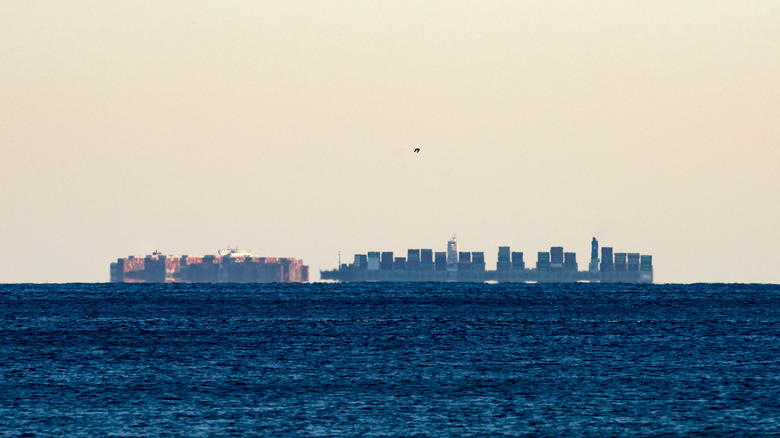The Truth About 'Fata Morgana,' Oceanic Mirages
To many, the word "mirage" might conjure images of a heat-scorched desert wanderer mumbling "water, water" as she shambles her way toward the palm trees of a desert oasis, only to have it — poof! — vanish when she gets too close. Or, it might be some distant object hovering above the light-rumpled sheen of an oceanic horizon, peered at by piratical dudes wielding telescopes and jugs of swiftly-depleting rum. Or, it might that be that Beastie Boys song — you know the line: "Oh my God, it's a mirage. I'm tellin' y'all, it's sabotage!"
Real oceanic mirages — "fata morgana," as they're called, named after the treacherous enchantress from Arthurian legend, Morgan le Fay — really are kind of like nature's version of optical sabotage. At least, that's what viewers of the so-called "ghost ship," The Flying Dutchman – likely an optical illusion, per Farmer's Almanac – might have said when they cursed fate for carrying them into the embrace of an damned vessel. Or, it's what the ship-goers aboard the Titanic might have said before they struck an iceberg, had they realized that their vision of the horizon was obscured by a fata morgana, as Smithsonian Magazine tells us.
As it turns out, fata morgana really are mere tricks of lights occurring under specific, predictable environmental conditions. Take a bit of terrestrial curvature, add some heat differentials, plot it out with some rulers, compasses, and math, and presto: we've got the cure for centuries-old sailors' paranoia.
Light refracted down or up through cold or hot air
In 2015, video footage from Jiangxi and Foshan, China, emerged of what appeared to be a floating city in the cloud. Out of all the wacky explanations outlined on Indian Express – aliens, conspiracies, NASA experiments, hoaxes, and the like — CCTV got it right in 2019 with their headline regarding a similar sighting in Yantai (viewable on YouTube): "Breathtaking Mirage Appears in East China." To the naked eye, it really does look like the boxy outlines of apartment buildings studding a clouded sky. So what exactly is going on? For that matter, why does a road shimmer on the horizon on a hot summer day?
As Jill Coleman, atmospheric scientist at Ball State University, offhandedly says at National Geographic, "It's called a superior mirage, which just means it's an upward projecting mirage." As Wired explains, a superior mirage — what we've dubbed fata morgana — appears when colder temperatures hover under warmer temperatures, known as a "thermal inversion." Light from a distant object, even one beyond the visible cut-off of Earth's curvature, passes through the colder, denser air, and is refracted down. To the eye, the light is processed at a higher height — hence floating, distant objects like city apartments and Flying Dutchmen. In the opposite case — an "inferior mirage" — hot air trapped under cold air projects the mirage down. Hence the whole "oasis in a desert" thing, or "shimmering road horizon" thing, which is actually just the sky.
An Arthurian enchantress gives way to 1st-century trigonometry
Back in the 1st century CE, Roman naturalist Pliny the Elder settled the whole curvature of Earth thing by using nothing more than his eyes and trigonometry. As calculations on Earth Science show, at three meters tall (about 10 feet), the curvature of Earth cuts off vision at a meager 6.2 kilometers (a little under four miles). If an object on the other side of the curvature is close enough to the cut-off, and tall enough, you might be able to see it, anyway — a mountain, for instance.
Of course, 17th century maritime dwellers weren't necessarily savvy on either the work of Pliny, or the as yet up-and-coming Scientific Revolution. As Safety 4 Sea tells us, when they saw a slightly hovering, wavering image of a ship off in the distance, seemingly appearing willy-nilly, they imagined it to be the ever-roaming ghost ship of a drowned crew that prowled the seas for eternity (good for scaring people into sailing safely, though).
As for the term "fata morgana," we have Normans (Vikings living in France) to thank, who took their Arthurian tales to Italy. In 1643, Jesuit priest Father Domenico Giardina looked out at the Straight of Messina from Sicily and described a city floating on "a base of a luminous crystal," per the Scuttlefish. Such phenomena became commonly described as "fata morgana," or "Fairy Morgan," after the Arthurian temptress who lured people to an underwater city full of illusions.


